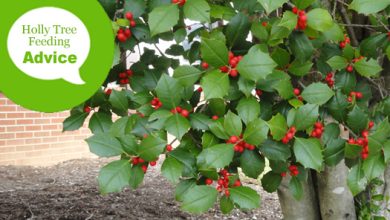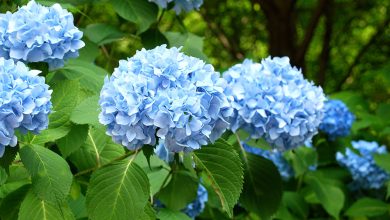Hanging Plants: [Planting, Care, Examples, Irrigation and Images]
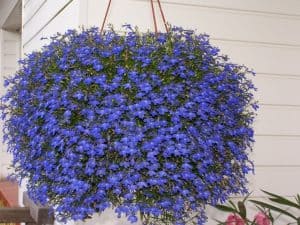
 How do you know what they are?hanging plantsAnd why not?
How do you know what they are?hanging plantsAnd why not?
Perhaps it has happened to you that you have a beautiful plant in your garden, but for some reason, its stems or flowers are always in the ground, unable to stand erect.
If that’s the case, maybe it’s aideal variety to be hung.
In fact, there are many plants and flowers that are ideal for hanging in baskets. This makes them look more beautiful and healthy, since they benefit from the heights to receive air and light.
Some even attract butterflies and hummingbirds, bringing life to our home almost immediately.
What are hanging plants?
Hanging plants are those whose stems are not upright, so the plant cannot support itself and tends to grow at ground level.
In this sense, there is a great variety of flowers and plants that arethey can grow in hanging baskets.The choice depends both on the size of the basket and the conditions of our home or garden.
Likewise, some climbing varieties, such as ivy and pothos, can be considered hanging plants, since in their natural habitat they entangle themselves in tree branches to get the necessary light.
In general, hanging plants don’t like excessive watering, but many do enjoy the sun.
In decoration, we can find two types of hanging plants:for interiors and for exteriors.
The former prefer little sunny environments, while the others enjoy sunlight and gentle wind, so they tend to be more resistant.
On the other hand, those baskets that are kept in the shade and away from the wind are easier to care for since they involve less watering.
Did you know…Are hanging plants usually ideal if we want to make a vertical garden?
Main care of hanging plants
We must take care of certain aspects if we want ourhanging plants are healthy and beautiful.
Light, watering, location, temperature, maintenance, pruning and the health of our plants are some of the things that we must take into account.
Light: What needs do they have?
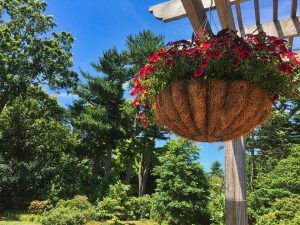 Because the vast majority of hanging plants thrive in dense, humid forests, many can thrive in low-light conditions, making them ideal for decorating interior spaces with artificial light.
Because the vast majority of hanging plants thrive in dense, humid forests, many can thrive in low-light conditions, making them ideal for decorating interior spaces with artificial light.
However, if you want your plant to be spectacular, it is best to try to place it in awell-lit place, avoiding direct sunlight.
Irrigation: How often and how?
Many hanging plants are tolerant of spaced watering. Therefore, irrigation is recommended.only when the earth begins to dry out in the deeper layers.
Depending on the climatic conditions where you live,once or twice a week is more than enough.
Keep in mind that excessive watering can cause the leaves to turn yellow and fall off easily.
Hanging Plants Temperature
hanging plantsThey are not usually demanding in terms of temperatureit means. On the contrary, they easily adapt to the climatic conditions of the place where they live.
However, excessive heat and drought are negative for the good development of its leaves, so they require more attention during hot and dry seasons.
In general, a constant temperature around 20 ºC is ideal.
However, there are some varieties, such as ivy, that prefer a cooler environment, between 16 and 18 ºC.
In winter, attention should be paid to the effects of heating on the highest leaves.
Location: Where should we plant them?
 Of course, hanging plants should be located in a high place,where they receive the necessary light.
Of course, hanging plants should be located in a high place,where they receive the necessary light.
In addition, this will allow them to dry out more easily than if they were in pots at ground level.
We must choose the location of our plants taking into account all the aspects that allow them to remain comfortable and healthy, so that they look great in our home or garden.
It is necessary to consider the size and weight of the plant, since at the time of irrigation it becomes heavier than usual. Likewise, it is very important that the pot support is well fixed to avoid accidents, either due to the wind or due to poor installation.
Maintenance: How do we pay them?
Depending on the species, the ideal isfertilize them with a liquid fertilizer every 3 weeks.
If the plant only grows on one side, it is best to turn it so that the development is even.
Pruning hanging plants
In general, hanging plants grow very fast, so once a month we should consider pruning.
Pruning is also beneficial to maintain the shape of our plant and contribute to spectacular flowering.
Plagues and diseases
Hanging plants are usually resistant varieties, so attacks by pests and diseases are not frequent.
In any case, health problems are usually caused by aexcessive watering and waterloggingon earth.
How to grow hanging plants?
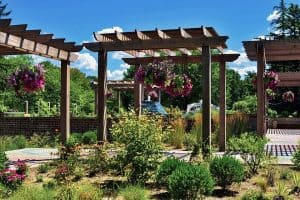 Hanging plants and vines can be displayed in various spaces. It is common to find them on balconies, pergolas, hanging planters, windows, etc.
Hanging plants and vines can be displayed in various spaces. It is common to find them on balconies, pergolas, hanging planters, windows, etc.
If you are interested in hanging them in pots or containers, there are different types to choose from. There are wire, wood, plastic and terracotta.
Of course, you must choose the most suitable, depending on the species, the size of the plant and the place where you want to place it, among other things.
But whatever the container you have chosen, you must make sure that it has a very good drainage.
Steps to make your hanging basket
- Line the basket with moss and cover it with black plastic with holes.
- Then put the soil on top and plant your plant.
To know more: 15 Examples of Hanging Plants for the Interior of your House
Some hanging plant recommendations
Below you can see some of the hanging plants that we recommend planting in your garden:
Petunia
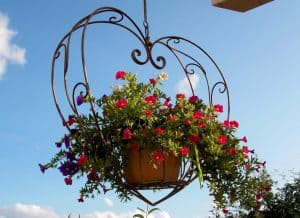 The Petunia is one of the most popular flowers and one of themost recommended hanging plants.
The Petunia is one of the most popular flowers and one of themost recommended hanging plants.
It blooms profusely and there is a wide variety of petunias in different colors, including black.
It likes a lot of direct sun and does not require frequent watering. In summer, preferably, watering should be daily. As for temperature, it prefers temperate zones protected from wind and rain.
It responds better if it is fertilized during the growing seasons.
Lobelia
Lobelia thrives in moderate temperatures. It is an annual plant with electric blue flowers and contrasting white throats that attract butterflies.
In very warm temperatures they can become perennial and last up to three years.
They easily reproduce by seed in spring, although they can also be reproduced by cuttings in autumn.
Preferably, it should be located in full sun and always watered from below, never from above, to avoid touching its flowers. If it is paid every 15 days, during the summer, this will favor its flowering.
money plant
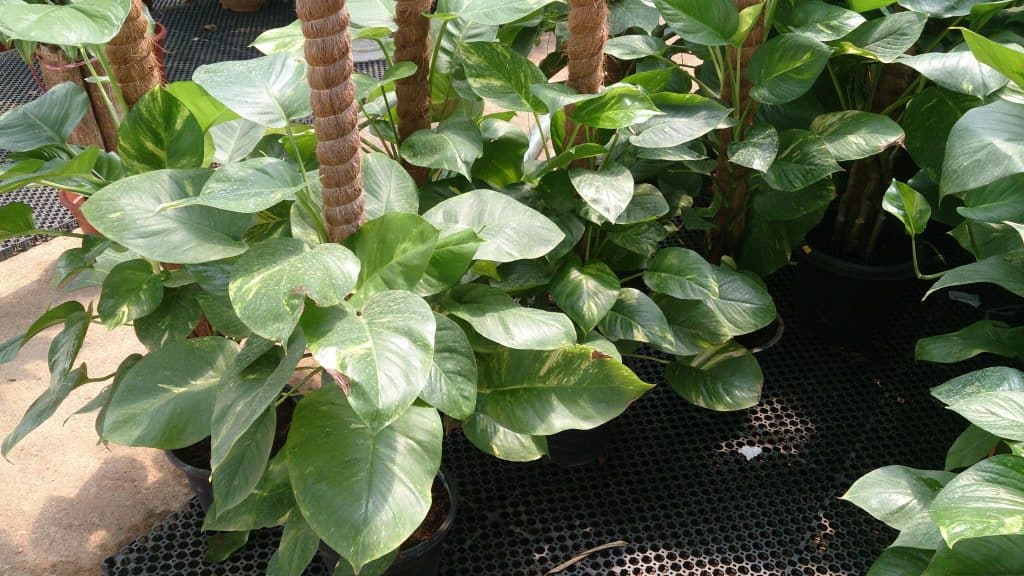 The Plectranthus verticillatus is popularly known asthe Money Plant.
The Plectranthus verticillatus is popularly known asthe Money Plant.
The money flower is characterizedfor its dense foliage and for its very rapid reproduction by cuttings,which will mean that in a few days you can have a new plant to sow.
It is also known as the dollar plant or Swedish ivy.
Fuchsia
The Fuchsia is one of the most elegant and colorful hanging plants. Prefers shade and cool summers.
Its stems cascade over the hanging basket with a mass of flowers of varying colors ranging from hot pink to orange, with showy purple or white trim.
They respond best to light daily sprays, regular fertilizations and moderate and effective pruning. And although they tend to wilt in the summer weather, there are more heat tolerant varieties like the Astoria or Jupiter.
Pothos
Pothos are one of themost versatile indoor hanging plants.
 It is an excellent air purifier, capable of absorbing and eliminating toxins such as formaldehyde, which is present in cushions and carpets.
It is an excellent air purifier, capable of absorbing and eliminating toxins such as formaldehyde, which is present in cushions and carpets.
They enjoy a variety of environments and adapt well to low light conditions, although this may lessen the variegation of their leaves.
It is recommended to let the soil dry a little between watering and watering. It performs very well in a wide range of ambient temperatures.
ribbons
The appearance of this plant always adds an interesting touch to any space where it is found. It is easy to grow and very hardy, making it a great starter plant for beginning gardeners.
Although they are indoor hanging plants, they can also be grown outdoors, protected from excessive sun and strong wind. Thrives well in indirect light and in evenly moist soil.
Strawberries
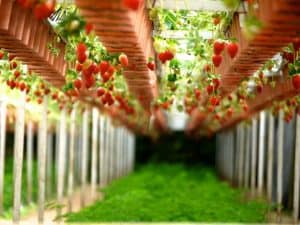 Strawberries can also make a great hanging plant.
Strawberries can also make a great hanging plant.
They can be planted in a pot, and if it is hanging, in a short time the stems will fall and we will be able to see our strawberries hanging.
In addition, the strawberry plant requires water and good fertilizer, but when it begins to grow it is fast growing.
Tomatoes
There are tomato varieties that also work very well as hanging plants.
For example, cherry tomatoes. However, like all tomatoes, they require a good supply of water (without flooding) and a lot of light.
Bougainvillea
It is a shrub whose flower is purple. It grows and climbs abundantly.
The only problem with it is that it tends to get quite dirty when it loses the blade. But when it blooms, it’s really pretty.
To know more: how to plant bumgabilia.
donkey tail
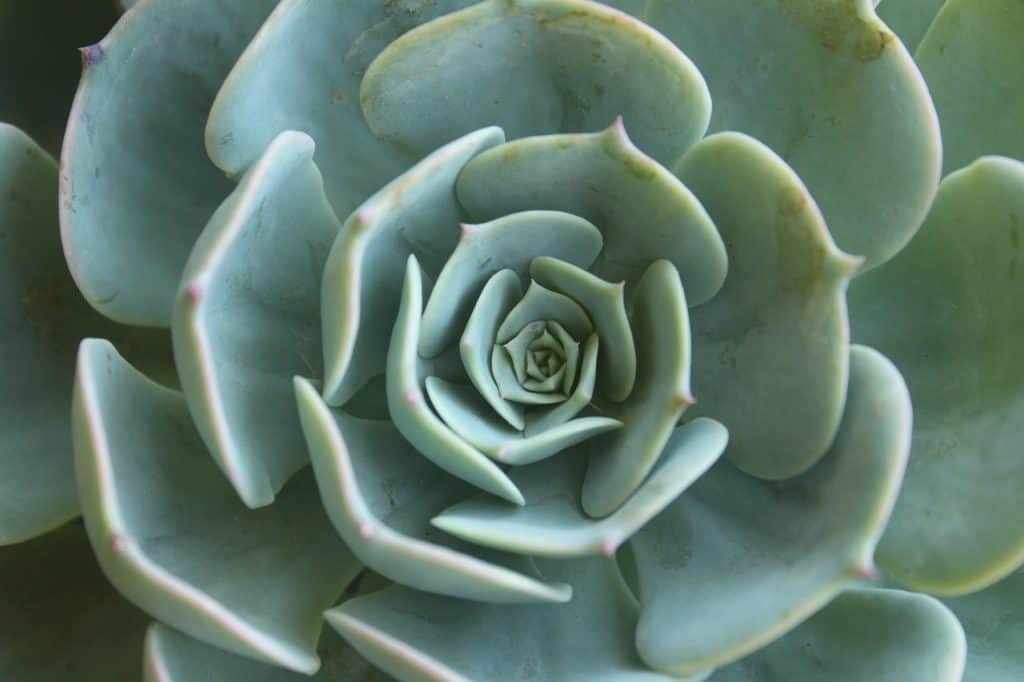 Originally from Mexico, the donkey tail is from the succulent family.
Originally from Mexico, the donkey tail is from the succulent family.
These plants are becoming very fashionable in interior decoration due to their ability to withstand high temperatures and the few watering needs they require.
The donkey tail is also a hanging plant that is very beautiful to decorate gardens, offices or home interiors.
To know more: how to plant donkey tail.
Calibrachoa
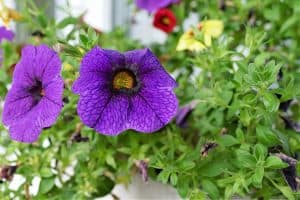 The Calibrachoa is a species of plant with a small size, but of great beauty that produces flowers of various colors, embellishing the place where it grows.
The Calibrachoa is a species of plant with a small size, but of great beauty that produces flowers of various colors, embellishing the place where it grows.
Due to its structure, many usually associate it with the petunia. However, they are two totally different species.
Having it at home will be a real pleasure because it has a very striking ornamental effect, either hanging or because of its creeping condition. In addition, it is capable of developing easily in wild land.
Wisteria or Glycinia
Another climbing bush.
The wisteria takes time to bloom, however when it does, it gives any garden a unique beauty. Hence, in addition to being considered a hanging plant, it is an ornamental plant used in many gardens (especially in Italy).
To know more: how to plant wisteria or wisteria.


